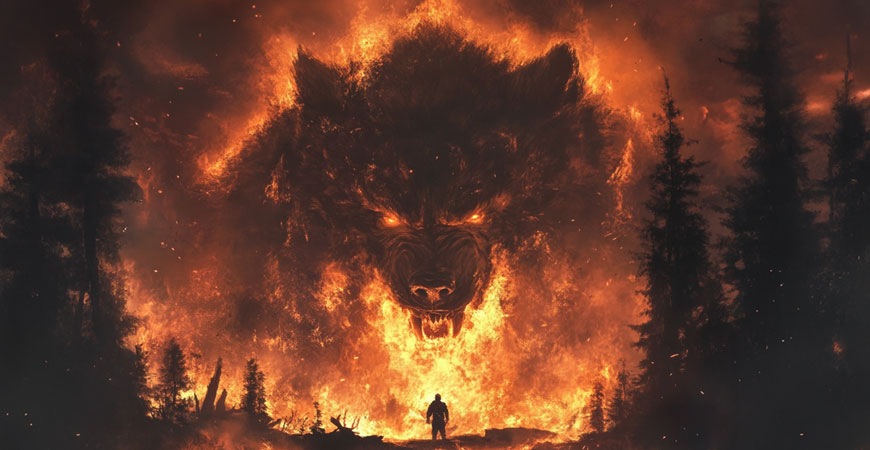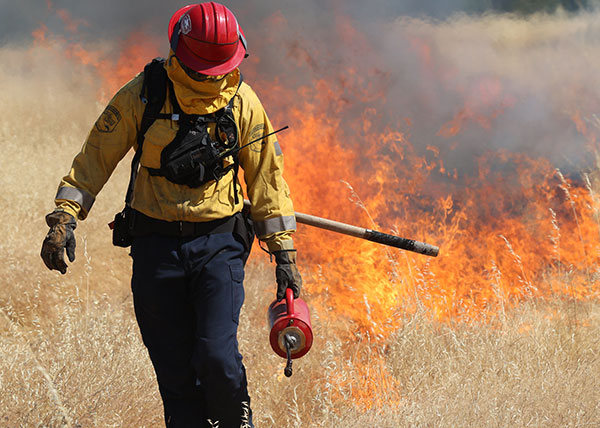
As wind-whipped walls of flame destroyed hundreds of Los Angeles-area residences last January, one media report framed the disastrous wildfires in beastly terms, saying they were “ripping through homes.” The report then shifted to militaristic imagery: “Firefighters here have an uphill battle.”
A day later, a journalist from a national newspaper rode in a helicopter over the blackened devastation. Earlier, an evacuee had told him a stricken neighborhood looked like a war zone.
“I wondered if that was an exaggeration,” the reporter wrote, “until I saw it myself.”
It can be tough to wrap our heads around a wildfire’s scope, speed and destruction. The Madre fire, which started July 2 this year and affected three California counties, burned an area about the size of Atlanta. It is only the 11th largest to torch the state since 2020; the biggest scorched more land than Rhode Island and Washington, D.C., combined. In extreme conditions, a wildfire can generate its own weather and race faster than a person can run.
This is where the power of words can exert itself. By using language borrowed from more human-sized levels of reality, people are better able to understand and respond to a fire’s dangers. Two UC Merced researchers studied two common metaphors in communication about wildfire: comparing it to a driven, hungry beast and to an enemy to defeat in war.
“A wildfire involves countless chemical processes happening in parallel over this huge expanse of physical space. We're not designed to comprehend processes with that amount of complexity and size,” said Professor Tyler Marghetis, who authored the study with fellow cognitive scientist Teenie Matlock, a UC Merced professor emerita.
The study found that while these metaphors are often effective in framing natural disasters and spurring people to action, they sometimes send the wrong message or evoke an unhelpful reaction to wildfire management. This makes it doubly important that communicators, especially media outlets and response agencies, use these descriptors with care.
Metaphors pop up everywhere in our lives, animating an emotion, giving a noun human traits, or reshaping concepts such as time and distance. They summon imagery that helps describe the otherwise indescribable.
He burned with rage.
X goes to infinity.
Justice is blind.
A sampling of headlines during the Los Angeles County disaster shows metaphors hard at work.
Devastating and deadly wildfires rage in Los Angeles
With firefighters stretched thin, residents battle to save homes
See how a small fire in L.A. turned into a monster, hour by hour
“Metaphors appear everywhere, from mundane descriptions of time to responses to climate crises. Let's think about the implications of which framing we adopt,” Marghetis said. “It's not that one is better than the other, it's that they offer different ways of thinking through a fraught problem.”

Marghetis and Matlock tapped a massive archive of television news broadcasts for their study. They looked at airings between 2009 and 2023, finding more than 150,000 instances of wildlife as the broadcast topic. The beast and war metaphors popped up every year.
The study found that fire management through planned, controlled burns is one area where the two metaphor styles can muddle the message. Framing flames as an invading military force can make it sound as if a burning landscape is unnatural and to be avoided at all costs. But fire is part of the normal life cycle of forests and wildlands, and controlled burns reduce underbrush that could fuel more dangerous blazes.
The war and beast metaphors can also complement each other, Marghetis said. The war metaphor can be effective because it invites a collective, unified response from people. Alternatively, a beast can be turned away by removing its food source, just as a fire can be controlled by removing fuel.
A similar study by Matlock in 2017 showed residents were more willing to evacuate if the official communication described the wildfire as a monster.
People differ in their motivations to prepare against wildfires. Some worry about losing their homes. Others may care about protecting an ecosystem.
“Metaphorical framing cuts across these perspectives,” the study said, “offering an integrated way to communicate to varied stakeholders about aspects of wildfire management.”



